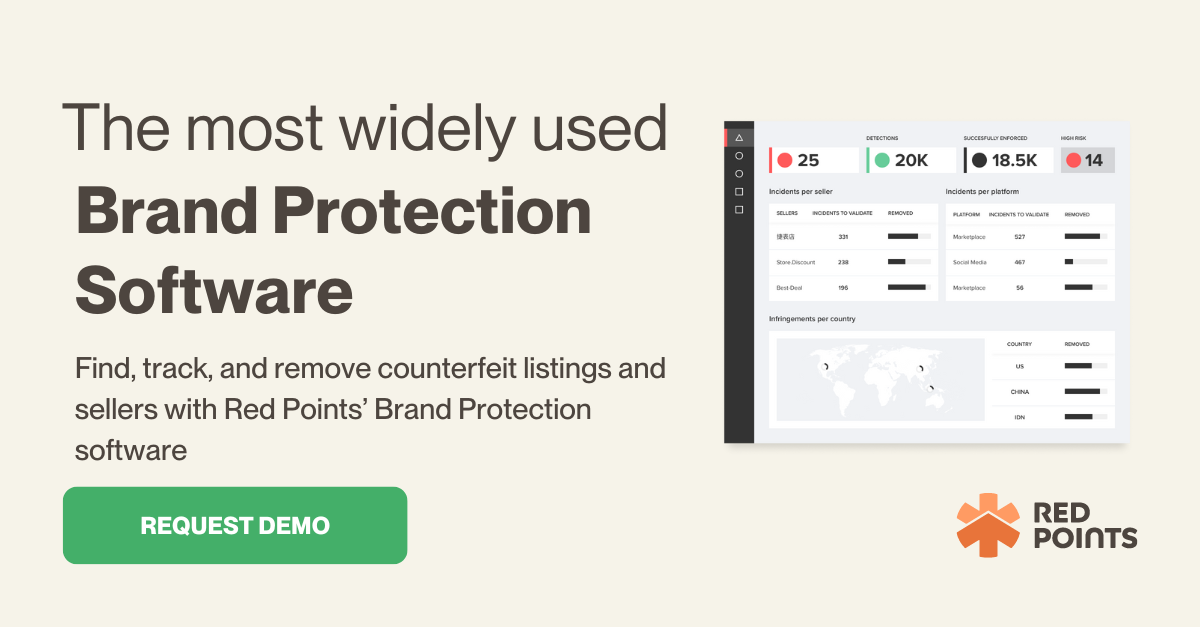If your business has fallen victim to copyright infringement or harassment online, working quickly to address the issue is necessary to protect your brand. If left alone, infringements and counterfeits can become dangerous for your customers and ruin your brand reputation. Cease and desist letters are a simple tool you can use to claim your rights before having to hire costly legal help.
As brand protection experts, we have helped thousands of content owners take down stolen intellectual property online quickly and efficiently. Read on to learn how to serve a cease and desist letter to quickly take down infringements and keep your customer’s brand reputation protected.

What is a cease and desist letter and what can it do
Safeguarding your brand against copyright infringement and online harassment has never been more critical. The shift towards a predominantly online business environment, accelerated by global events like the COVID-19 pandemic, has opened new avenues for intellectual property theft and digital misconduct.
A cease and desist letter remains a pivotal first line of defense against counterfeiters, offering a swift and cost-effective means to assert your rights and demand the cessation of unlawful activities. As seasoned brand protection specialists, Red Points has guided countless content owners through the process of reclaiming their intellectual property swiftly and effectively.
This article is your comprehensive roadmap to deploying cease and desist letters efficiently, ensuring the safety of your brand’s reputation and the trust of your customers.
What is a cease and desist letter and what can it do
Cease and desist letters serve as an official notice to the recipient that they have violated laws and must remove the stolen or harassing content. What a cease and desist letter (C&Ds) does is help to claim your intellectual property rights and take down stolen or defamatory content online. C&Ds give the offender a chance to remove the content before facing legal repercussions and can save you from hefty legal fees.
Not sure what counts as infringement online? Any time someone uses your trademark, web content, product photos, names, and more, they have infringed on your copyright. If you’re having trouble determining if infringement has occurred, our full guide on copyright infringement can help.
In addition to addressing online infringement, cease and desist letters can also help combat online harassment. According to Justia, negative reviews and comments online qualify as defamation if they are “false statements of facts,” with the intent to damage your reputation (Online Defamation).
IP infringements and online harassment are both large threats to your business and brand reputation, especially if left alone to spiral out of control. Sending a cease and desist letter is a great first step to take when you encounter one of these threats online.
How to serve a cease and desist letter
First, you must write your C&D letter, which is a relatively simple process. A lawyer can be hired to draft your letter, but this can be pricey and is not absolutely necessary. You can write and send a cease and desist for free yourself, and there are many sample templates you can use to get started.
What information should you include in a cease & desist letter?
- Your name and contact information (phone number, email, and address)
- The recipient’s name and contact information (include business info if applicable)
- Description and proof of the infringement or harassment being addressed
- Notice that the offending content must be taken down
- A deadline to comply before legal action will be taken against the recipient
If you’re not sure how to send a cease and desist letter, it is actually quite simple. Once written, you can send a C&D via email, mail, or even in person. Sending it by certified mail is a good option because it requires a signature from the recipient, so you’ll know when they receive it.
Once sent, your C&D letter is effective for as long as the deadline you provide. Most C&Ds include a deadline of 10-15 days for the recipient to respond and/or remove the violating content. If you receive no response and the content remains online, it is a good time to follow up with legal advice to move forward.
Steps to send a cease and desist letter
Once you’ve identified infringement or harassment online, you must take action quickly to protect your brand. Gather evidence of the incident, as well as the laws the offender is violating, so your notice is taken seriously. Once you have your information together, write your letter and send using the following steps.
Follow these steps to send your Cease and Desist letter:
Step 1: Acquire the recipient’s contact information.
If not readily available, ICANN is a great resource for finding the contact information of domain registrants. If the offending content is up on a social media platform or online marketplace, they should also be able to help you obtain this information. These platforms need to follow strict copyright and harassment laws to stay in business, so they should help take action against these offenders.
Step 2: Write your Cease and Desist letter, including the required content above.
When writing your Cease and Desist letter, it’s important to keep tone in mind. Make it clear that you are taking this issue seriously and that the recipient will face legal repercussions if they do not heed your notice. On the other hand, ensure you aren’t attacking the recipient or threatening them beyond legal repercussions, as this could be considered harassment on your part.
Step 3: Send your C&D letter via mail, email, in person, or another method.
No matter how you send your C&D letter, you must keep a record of how and when you send the letter. This will serve as proof that you sent a legal notice to the offender if you have to take further legal action. Record the date you sent the letter, the date of the deadline you gave the recipient, and any additional correspondence you may have with them.
Step 4: Take further action if your notice is not heeded by the recipient.
If the recipient takes no action within the deadline provided, it’s vital you take additional action. You can do this by obtaining a cease and desist order from a judge, which usually includes providing proper evidence and any records you have. Having a record of your C&D letter is a good way to show you’ve provided legal notice to the offender.
Pros and cons of a cease and desist letter
Dealing with infringements and harassment online can be incredibly stressful, especially when they are putting your business at risk. It’s important to choose your plan of action carefully and think through the pros and cons of whatever path you take. Sending a cease and desist letter comes with many pros, but they aren’t without their challenges.
Pros:
- You can send notice to the offender immediately.
When your brand reputation, revenue, and customers are at risk, you want to act as quickly as possible to address the threat. Because you can write and send a Cease and Desist letter yourself, you can have it sent very quickly. You can also provide a short deadline that will allow you to take additional action within a week or two.
- It saves time and money.
It can be very beneficial to have legal assistance when dealing with threats to your brand, but it comes at a cost. Finding and working with a lawyer takes time, and legal fees tend to be quite heavy. C&Ds are a good first step to deal with infringements or harassment online before investing in legal help.
- It serves as a record of notice for future legal action.
If you do have to pursue further legal action, either in hiring a lawyer or appealing to the court, the process can be daunting. Having a record of a C&D letter can make the process easier. It shows that you’ve identified a violation and provided a notice, so you can move on to the next steps without sending another notice.
Cons:
- The recipient can simply ignore your takedown request.
Cease & Desist letters serve as notices to the recipient that they are violating the law, but they don’t guarantee they will take down the content. While you wait around for the deadline to pass, the harmful content is still up online and puts your brand at risk. Many scammers know their actions are illegal and won’t remove the content until they are forced to, meaning more work and time on your end.
- You may still need to invest in additional legal help and brand protection services.
If the recipient of your C&D letter does not take down the offending content, you will have to take further action. This will likely mean hiring a lawyer or getting legal help in some form or another, which will likely come with a hefty fee.
The process of sending out individual cease & desist letters to each infringer is extremely manual, and can take up a lot of precious time away from other important tasks. Automating the process with Brand Protection Software can help overcome this, and streamline the sending process considerably.
- They will not protect you from future attacks.
A C&D letter will only help you take down the particular content in question in your letter. It will not keep your brand protected from infringements or harassment that arise in the future. Investing in a brand protection service that monitors for infringements can help you stay protected from any future IP attacks.
What’s next
Online infringements and harassment put your brand at risk, so working quickly to take them down is essential to protect your brand. The impact of IP thefts is great, and your business simply cannot afford to let infringement and harassment go unaddressed. Knowing how to send a cease & desist letter will ensure you are prepared to fight against these threats and keep your brand reputation safe.
Prepare for future threats to your brand by investing in a brand protection service like Red Points. Request a demo to talk with an expert and learn how our services can prevent infringements and harassment online from damaging your brand.




